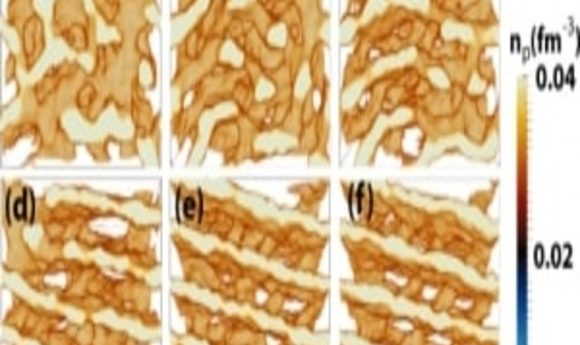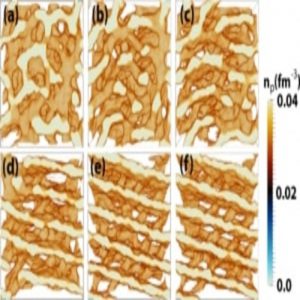Cell biology meets astrophysics

Ancient elements found within our bodies prove we are made of star dust. And now new research has identified constructions found in both dense neutron stars and the endoplasmic reticulum.

“Nuclear pasta” assembly is visualized using molecular dynamics simulation, with helical ramps connecting the sheets and bearing striking similarity to membrane folds in the endoplasmic reticulum (1).
From pinecones demonstrating Fibonacci’s golden ratio to the fractal designs found in ferns, geometrical patterns regularly crop up throughout nature. While you can see these examples walking through a local park, matching patterns are also found much further away and on smaller scales.
Now, collaborating biophysicists and nuclear astrophysicists have identified self-assembling structures in both neutron stars and the endoplasmic reticulum (ER), differing in density by 14 orders of magnitude but determined by similar geometrical constraints. These findings may create new research models, with neutron stars studied under a microscope and astrophysics simulations used in cell biology.
Serendipity allowed the two different research disciplines to make the connection between the structures’ similarities. “We got lucky. One of my simulations of neutron stars was published in the American Physical Society newsletter, and biophysicist Greg Huber recognized it as something that looked similar to his own work on the ER morphology. After that, we had to collaborate! It was too striking of a resemblance not to,” said Indiana University Nuclear Astrophysicist Matt Caplan, who was an author of the research published in Physical Review (1).
This collaboration was only possible after overcoming a terminology language barrier. “We have completely different names for different things, so learning the language of biophysics was key. Our main challenge was building a Rosetta Stone that both collaborating teams could use that will be a useful reference in the future research,” said Caplan.
Within a neutron star’s crust is a dense mixture of protons, neutrons, and electrons caught between long-range repulsive forces and shorter-range attractive forces. The competition between these forces causes matter to split into dense regions divided by voids, with the structures termed “nuclear pasta” since they resemble sheets used when baking lasagne. These sheets are joined by spiral-shaped ramp-like junctions, similar to the paths connecting the floors of a multi-story parking garage. Huber recognized in this configuration a striking likeness to membrane folds found in the ER that increase the surface area for ribosome factories.
To find out if resemblance between these structures is due to self-assembly, the team simulated the motion of randomly distributed protons and neutrons to calculate how they move and the shapes they form, visualizing the structures. Excitingly, they found that many of their systems spontaneously self-assembled to form flat sheets connected by the helical ramps, with the geometry similar to that observed in the ER.
There are dramatic differences between nuclear pasta and terrestrial cell biology. The only thing denser than a neutron star is a black hole, with its gravitational field nearly a trillion times greater than that found on earth. Cellular biology must adhere to a different set of rules, complying with the entropy of water and biomolecular interactions. However, the structures both adhere to similar dynamics following common geometric considerations, showing independence of the details of microscopic interactions.
“We are hoping to adapt a pasta model to study biological systems. It may be difficult for biophysicists to simulate and study membranes looking at exact microscopic interactions. But our model is somewhat simpler, and we can study things like self-assembly much easier,” stated Caplan. “Conversely, nuclear pasta can’t be produced on earth and studied experimentally. To have their work as a reference as an idea of what to look for and directions to go in is going to be incredibly helpful.”